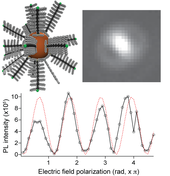Highlight
Enhanced Optoelectronics in Single Hybrid Nanostructures
Achievement/Results
Under IGERT funding, Kevin Early has carried out collaborative research on hybrid quantum dot / conjugated organic nanoscale structures that exhibit enhanced optoelectronic properties. These nanostructures, referred to as CdSe-oligo(phenylene vinylene) or CdSe-OPV, consist of an inorganic semiconductor nanocrystal to which rigid light-harvesting organic molecules are attached. Research on these hybrid nanostructures is part of an ongoing collaboration between Prof. Todd Emrick’s group (PSE), where the nanostructures are synthesized, and Prof. Mike Barnes’ group (Chemistry), where Kevin studies the optical physics of charge and energy transport between the quantum dot and organic ligands on single nanostructures using scanning probe and single molecule fluorescence microscopy.
We have demonstrated a host of enhanced photophysical properties in these nanostructures, including enhanced stability under prolonged exposure to intense laser fields, efficient energy transfer from the organic molecules to the quantum dot core, control over both polarization state and number of emitted photons, and reduced fluorescence intermittency. Current research efforts are aimed at determining the mechanisms underlying instabilities in the emission of single nanostructures, with the goal of achieving single photon-on-demand capabilities from single structures. This research represents a number of significant advances toward the incorporation of this class of nanostructures into optoelectronic and photovoltaic devices, where understanding of charge and energy transport is critical to device functionality.
Address Goals
This accomplishment highlights breakthrough interdisciplinary research involving IGERT Trainee Kevin Early’s productive collaboration between two UMass Amherst research teams, Prof. Todd Emrick’s group (Polymer Science & Engineering) and Prof. Mike Barnes’ group (Chemistry). The research’s timeliness with respect to the National need for alternative energy sources clearly addresses the primary strategic goal both because it breaks new ground in the understanding of charge and energy transport and because it has achieved significant advances toward incorporation of nanostructures into optoelectronic and photovoltaic devices, i.e., technologies that help to extend the Nation’s global leadership in fundamental, transformational science and engineering.
Regarding the secondary goal, it is addressed by Kevin’s bridging of the two disciplines of Chemistry and Polymer Science to achieve these results. In doing so, he not only has benefited himself and his education, but also has served as an excellent example to other graduate students in the two groups of what can be achieved through interdisciplinary collaboration.






